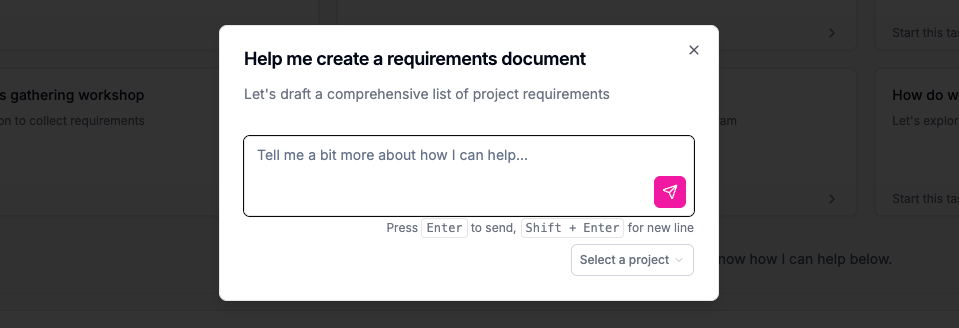
Why Requirements Documents Matter
In an AI technology buying process, clear requirements documentation is essential because:- It creates alignment among diverse stakeholders with varying levels of AI knowledge
- It reduces risk of selecting incompatible or insufficient solutions
- It accelerates vendor evaluation by establishing clear criteria
- It prevents scope creep by explicitly defining boundaries
- It provides a benchmark for success after implementation
Template Structure
The Requirements Document Template guides you through collecting and organizing information in a systematic way:1. Project Details
- Project name and owner
- Executive summary
- Timeline and key milestones
2. Project Description
- Purpose and objectives
- Current situation assessment
- Key challenges driving the need for change
3. Project Scope
- In-scope capabilities and outcomes
- Explicit out-of-scope items
- Key constraints (budget, timeline, resources)
4. Business Drivers
- Quantifiable business outcomes (revenue growth, cost reduction)
- Improved customer/employee experience metrics
- Risk mitigation goals
5. Current Process
- Analysis of existing workflows and systems
- Pain points and limitations
- Stakeholder perspectives
6. Future Process
- Vision for transformed workflows
- Expected changes to roles and responsibilities
- Technology integration expectations
7. Functional Requirements
Each functional requirement includes:- Unique identifier
- Detailed description
- Priority classification (Must/Should/Could Have)
- Requirement owner
- Impacted teams
8. Non-Functional Requirements
Categories include:- Security (authentication, encryption, access controls)
- Performance (response times, scalability, throughput)
- Usability (accessibility, user interface standards)
- Compliance (regulatory requirements, certifications)
- Integration (API requirements, data exchange formats)
9. Glossary
- Definitions of technical and business terms
- Clarification of ambiguous terminology
- References to industry standards
10. References
- Links to supporting documentation
- Sources used to develop requirements
- Related project materials
AI-Specific Requirements Considerations
For AI procurement specifically, the template guides you through key considerations:Data Requirements
- Data quality, quantity, and diversity needs
- Training/testing data availability
- Privacy and compliance constraints
Model Capabilities
- Accuracy and performance expectations
- Transparency and explainability needs
- Handling edge cases and uncertainty
Integration Requirements
- API specifications and data formats
- Latency and throughput considerations
- Authentication and security protocols
Governance Requirements
- Monitoring and audit capabilities
- Bias detection and mitigation
- Model retraining procedures
How to Use the Template
- Head to your dashboard in Kowalah and select “Build me a Requirements Document” from the tasks
- Answer guided questions about your situation and needs
- Add team members within a project to collaborate on specific sections
- Upload existing documents for context and reference
- Review and refine the document with stakeholders
- Export to preferred format (Word, Excel, PDF) for sharing
- Contextual guidance on best practices
- Examples from similar organizations
- Explanations of why each section matters
- Structured formats that ensure completeness
Example: AI Requirements Document
Here’s an abbreviated example of how a requirements document might look for a company implementing a generative AI solution for customer service:Benefits of Using This Template
- Thoroughness: Ensures all critical aspects are considered
- Structure: Provides organized, consistent documentation
- Collaboration: Facilitates input from different stakeholders
- Clarity: Reduces ambiguity and misunderstandings
- Efficiency: Speeds up the requirements gathering process
- Traceability: Makes it easier to track requirements through implementation
Next Steps
After completing your requirements document:- Move to vendor selection using your requirements as evaluation criteria
- Create a scoring matrix to systematically evaluate vendors against requirements
Vendor Meeting Template
Ready to meet with potential vendors? Use our Vendor Meeting template to plan your agenda and questions.

